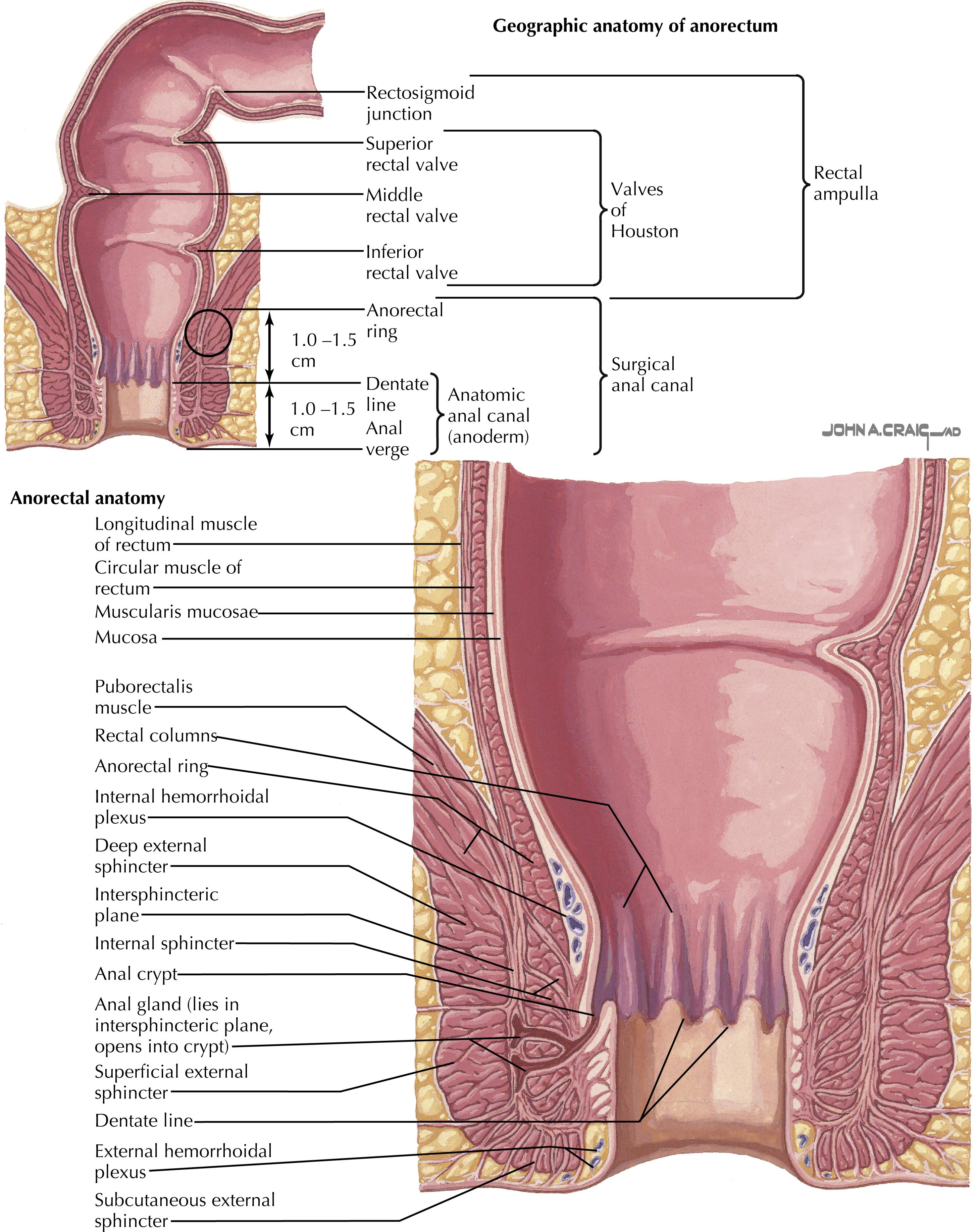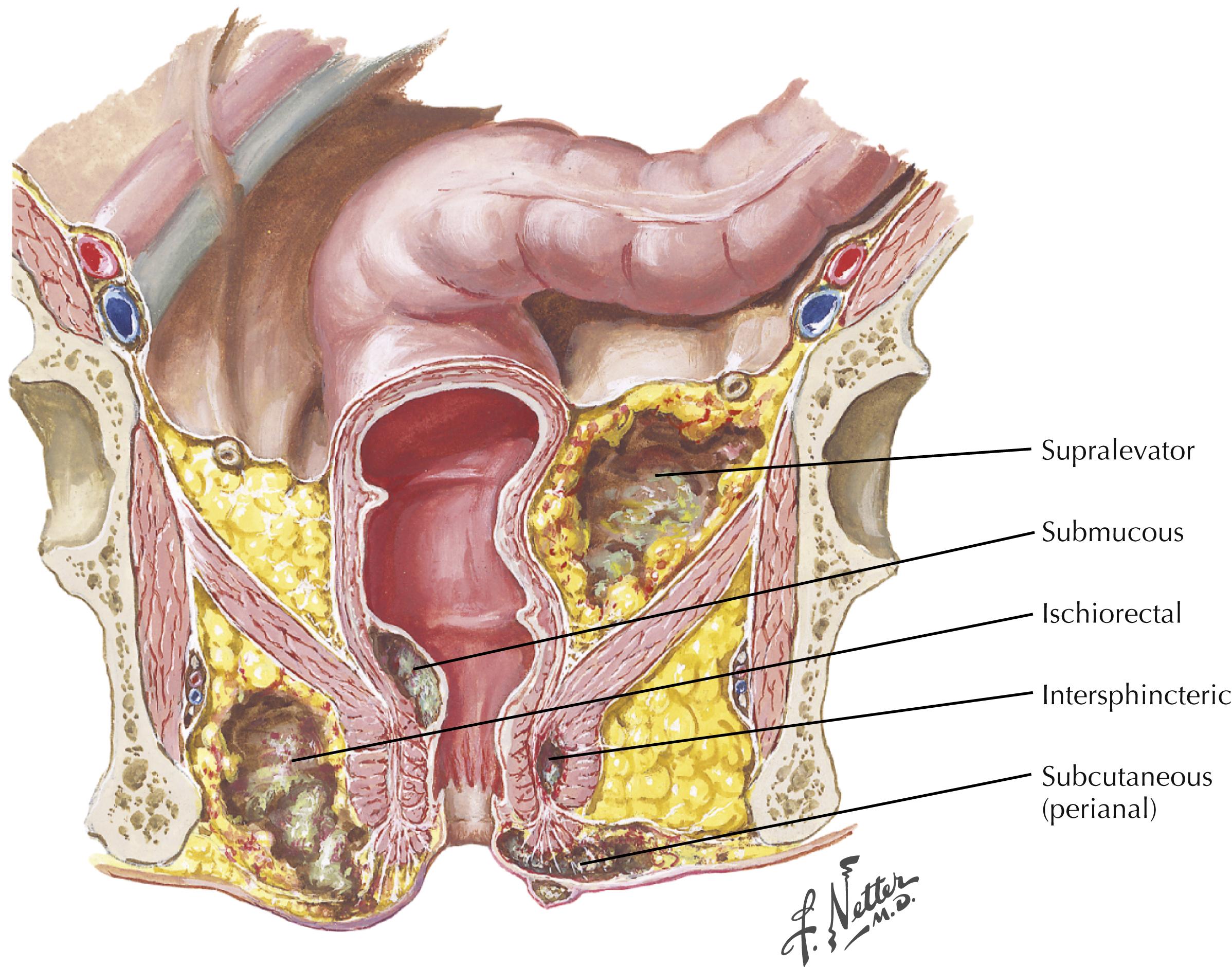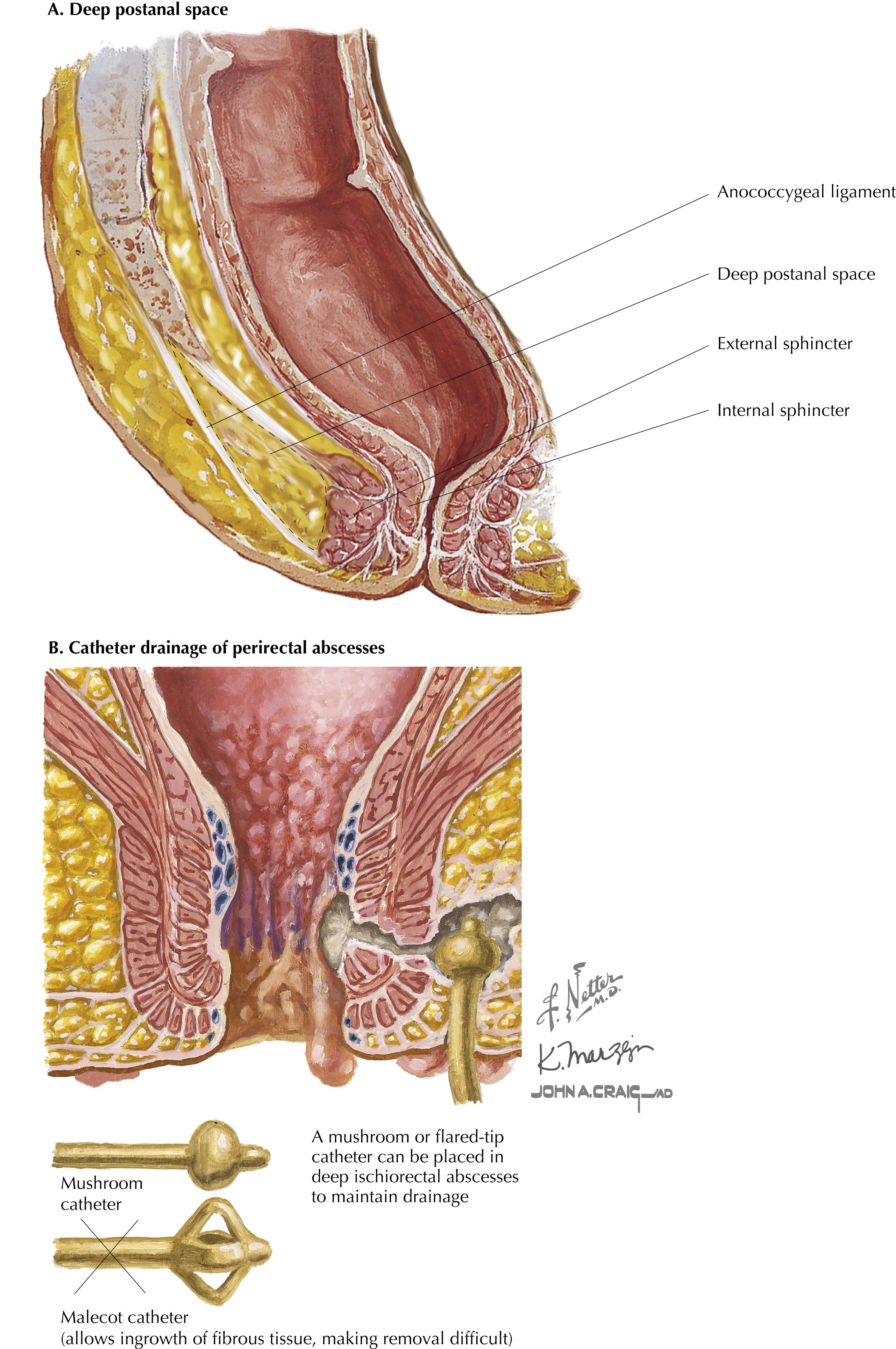Physical Address
304 North Cardinal St.
Dorchester Center, MA 02124
Perianal sepsis is a common problem that can be handled simply and successfully if treatment is based on an understanding of its anatomy and pathophysiology. The anatomy of the anus and the surrounding areas of the pelvis and perineum is complex, and sepsis in the area can be complex also. The aim of this chapter is to explain perianal sepsis in the context of anatomy and to describe the way in which treatments are determined by this relationship.
Most cases of perianal sepsis begin in an anal gland. Up to 10 of these glands are distributed around the anus, with each main duct passing from the gland opening at the base of an anal crypt through the internal sphincter into the intersphincteric space. Here the branches of the gland are dispersed. Anal crypts are located at the dentate line, at the proximal extent of the squamous epithelium of the mid–anal canal. These crypts form the lowest end of the anal columns of Morgagni, which extend vertically, cephalad from the dentate line through the anal transitional epithelium into the rectum ( Fig. 33.1 ). Abuse of anal function that occurs with straining at stool and frequent defecation can cause edema of the anoderm and potentially block the openings of the anal glands.

Pressure within the anal canal tends to be highest front and back, making the anterior and posterior midlines the common places for deep mucosal splits that lead to fissures, and for blocked anal glands that lead to abscesses and fistulas. A blocked anal gland means that gland secretions accumulate and are then prone to bacterial overgrowth, gland rupture, and sepsis. Sometimes the blocked duct clears and the sepsis can settle, but if this does not happen, the increasing septic pressure enlarges the abscess and forces it through the perianal tissues along lines of least resistance. At some time in this evolution the patient will be aware of a constant and increasing pain. As the sepsis worsens, the pain will become increasingly severe, and if the abscess has become more superficial, a lump may be palpable. Sometimes an abscess will start to drain through the gland duct back into the anus (this can often be seen during a careful anoscopy, the bead of pus showing the position of the infected gland); however, spontaneous drainage through the skin is common.
There are a variety of directions in which worsening perianal sepsis can extend, and this is reflected in its categorization, summarized in Fig. 33.2 . The categories reflect the spaces around the anus and extraperitoneal rectum, where increasing pressure of sepsis causes expansion of the abscess. The path of the sepsis in the formation of an abscess determines the track of the fistula that results from the sepsis, if that is the patient’s fate. Therefore the site of the abscess can determine the classification of the fistula ( Table 33.1 ).

| Abscess | Fistula |
|---|---|
| Perianal | Intersphincteric/Low trans-sphincteric |
| Ischiorectal | Trans-sphincteric |
| Submucosal | Subcutaneous |
| Intersphincteric | Intersphincteric/trans-sphincteric, depending on how it is drained |
| Supralevator | Suprasphincteric |
| Extrasphincteric | Usually iatrogenic |
At the bottom of the intersphincteric plane is the perianal space: subcutaneous tissue containing the external hemorrhoidal plexus. In it, fibers of the longitudinal rectal muscle pass through the lowest part of the external sphincter and attach it to the skin (corrugator cutis ani). If the sepsis passes downward in the intersphincteric plane, it will reach the subcutaneous perianal space and, being somewhat contained by the muscular and fibrous septa, will form an easily detectable abscess. This is the most common type of perianal abscess and is easily diagnosed on examination as a discrete lump that is erythematous, tender, and sometimes fluctuant. Fluctuance is a useful sign, because it shows where the pus is trying to exit through the skin and is the target for incisional drainage.
Depending on the size and depth of the cavity, the abscess can be unroofed or drained with or without an appropriately sized mushroom drain. If used, a drain is removed in 7 to 10 days. Packing is discouraged, because it must be changed daily and is painful. About 30% of patients develop an anal fistula, which will be either low transsphincteric or subcutaneous. Recent data suggest that postdrainage treatment with ciprofloxacin and metronidazole for a week can minimize fistula formation. In addition, searching gently for a fistula at the time of abscess drainage can allow seton drainage or fistulotomy, as appropriate, and prevention of later complications.
In an intersphincteric abscess, the infected anal gland forms an abscess in the intersphincteric plane, but it is detected before it has tracked in any direction. It is not usually visible on external examination but can sometimes be palpated or seen on anoscopy (usually with the patient under anesthetic). Pure intersphincteric abscesses are clinically uncommon because there is no external lump. In this respect they are like sepsis in the deep postanal space. Severe constant anal pain is an indication for examination under anesthetic, during which time pus can often be expressed through the anal gland. This offers the opportunity to drain the abscess by opening the gland. Otherwise, drainage can be done as indicated by the position of the pus and the nearest point of access, either through the perianal skin, the anoderm of the anal canal, or through the ischiorectal fossa. The point of drainage and the track used to access the abscess determine the anatomy of any resulting fistula.
The external anal sphincter is the medial border of the ischiorectal space (and the anterior border of the deep postanal space) ( Fig. 33.3A ). If sepsis extends from the intersphincteric space laterally through the internal sphincter, it will reach this large, fat-filled space, which offers little resistance to the development of an abscess. An expanding abscess can also spread circumferentially around the anus in this plane and present as a horseshoe. The degree to which this happens depends on the unique bacterial flora causing the infection and the patient’s innate ability to contain them. Ischiorectal abscesses can be very large and distort the buttock. If treatment is delayed, there may be systemic symptoms. On examination there is not usually an obvious point of fluctuance, although a general swelling is seen. The most erythematous area is the best target for drainage, and the presence of pus can be confirmed by aspiration with a large-bore needle. In some cases, drainage can be done in the office under local anesthesia, but a more effective and comfortable option is under general anesthetic in the operating room. Ischiorectal abscesses are deeper than perianal abscesses and so unroofing is not a good option. With the patient asleep, the size of the cavity can be assessed with an instrument or a finger, a counter-incision made at the edge of the cavity, and a drain placed through and through. If there is no tracking, a mushroom drain is inserted, as large as is necessary to ensure free drainage of the pus ( Fig. 33.3B ). Depending on the size of the abscess, the drain can be removed in 10 to 14 days or downsized to a smaller one if necessary.

A deep horseshoe abscess usually originates from an infected posterior midline anal crypt. The sepsis extends posteriorly into the deep postanal space and then spreads laterally into the ischiorectal spaces, often detected as a tender mass on the lateral aspect of the perineum. Drainage of the pus through the most obvious point of sepsis leads to a deep cavity that communicates across the midline in the deep postanal space to the other side of the perineum. A midline incision is made behind anus, entering the deep postanal space, and each “arm” of the fistula is controlled by a large seton-type drain (usually a Penrose drain) placed between the midline counterincision and the lateral incision. Probing through the midline incision will often find the internal opening of the fistula and allow a seton to be passed from the incision to the infected crypt along the transsphincteric track. The “modified Hanley Procedure,” which involves widely opening the deep postanal space and an extensive sphincterotomy, has been recommended for treatment of horseshoe abscesses. A less radical technique of insertion of an effective seton into the fistula track without division of muscle is preferred, and a delayed advancement flap repair of the internal opening.
Become a Clinical Tree membership for Full access and enjoy Unlimited articles
If you are a member. Log in here